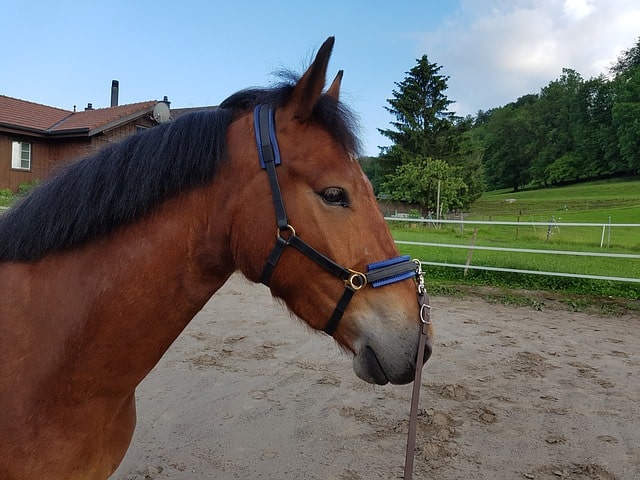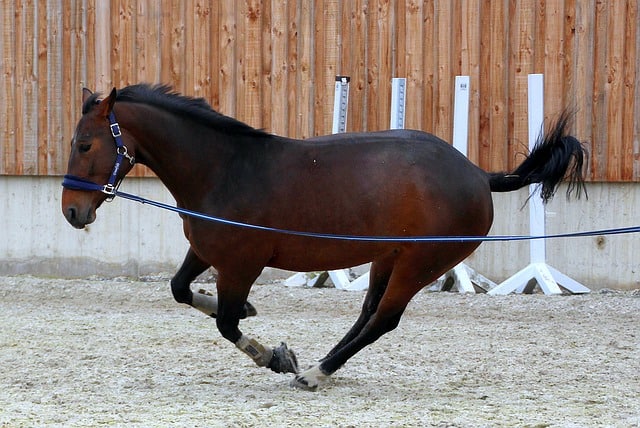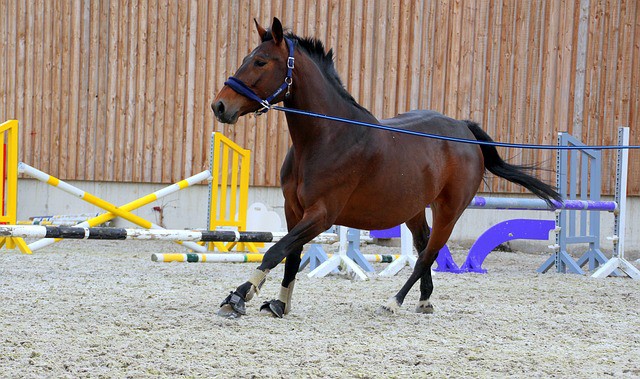Well I think if you are an Equestrian reading this, I bet that at some stage you have lunged your horse. Perhaps you incorporate lunging into your horse’s weekly schedule? Perhaps you use lunging when starting off your young horses? Or maybe you just use lunging as a way to take the fizz out of your over excitable equine? Whatever the reasons you choose to lunge your horse, have you ever wondered what are the benefits of lunging a horse?
Well to begin with lunging forms one of the initial steps of the breaking process with horses, it teaches your horse to respond to your voice commands and to work on a circle on both reins, prior to being backed for the first time.
Lunging also is used at this stage to help your horse to develop the correct muscles to carry the rider.
Once your horse is broken and riding, lunging can be very useful way of improving their flexibility and suppleness in their work, while also improving their transitions both upward and downward.
Lunging is also an excellent way to calm your over excitable equine, by eliminating any bucking or high jinks and focusing them on work, prior to ridden exercise.
Plus lunging is a wonderful form of exercise when you are short of time, and gives you the ability to give your horse a quality work out in about 20 minutes. Here, I will further discuss the benefits of lunging a horse, and why I believe it should be part of your horse’s routine.
Lunging the horse as part of the breaking and training process.

When you first bring your young horse in for breaking, one of the first things after the initial leading and handling phase, is that you will teach your horse to lunge. This will help get the horse used to you and your voice aids. I like to be able to start the lunging process in an enclosed space, such as a lunge pen or arena, with the horse just in a simple cavesson, with no bridle.
I use this initial training to teach the horse the meaning of the voice aids that I will be using in his training; such as walk, trot, canter, whoa and stand. I have found teaching this to your horse while having them on the lunge circle allows you to have a little more control.
In my experience while teaching the upward commands, allow your voice to be chirpy and energetic, and for downward transitions, it is important to use softer, longer tones, such as whoaaa, waaaalk.
Plenty of praise and voice reassurance will work wonders as will the odd treat, when the work is complete.
I believe it is important to use your voice as much as possible in the early stages, so that the horse learns your voice commands, as you will be using them later when you move into the backing and riding phase of his/her training.
Lunging To Help develop the correct muscles and strength to carry the rider.
Lunging is also a way of preparing your horse to carry the rider. The horse is genetically built to be a plains grazer, his basic design is to graze wide open spaces and flee from predators in a straight line. He is not designed to carry a rider or to work on turns and circles.
The lunging phase of the breaking and training of a horse was introduced to help the horse’s body to get used to working on turns and circles. As the training progresses the horse is also encouraged to lower his head and neck in the lunging phase. This again helps to develop the correct muscles, so that your horse will be strong enough to carry the rider’s weight comfortably without pain.
Lunging to improve your horse’s suppleness.
Once the horse is in work, regular lunging can be used to improve your horse’s suppleness. The use of trotting poles or cavaletti poles when lunging will encourage the horse to lower his head and neck, lift his spine, improving the top line muscles. This work will also improve the action and engagement of his hind leg, as he has to lift his legs a little higher to work correctly over the poles. When this gymnastic type of work becomes part of your regular routine, you will see your horse become more supple, with more engagement of the hind leg; this in turn will lead to improvements in his ridden work.
Lunging to encourage your horse to be more responsive through transitions.
Lunging can also be used as a way to encourage your horse to be more responsive during transitions. So when working the horse on the lunge, you can use your voice aid backed up by flicking the whip, to encourage you horse to make crisper more responsive upward transitions. The idea is to ask for transitions in quick succession, both upward and downward.
Some horses are dull on the upward transitions and good on the downward, while a sharper horse tends to be the other way around. A little patience is necessary to teach your horse correct transitions both upward and downward. However, through repetition and reward your horse will become more responsive and supple through his transitions’ both upward and downward.
This type of work is perfect for the type of horse that is usually a bit lazy to the aids or the horse that is a little too forward. Once he improves on the lunge and understands better what is required of him, this can be again transferred to his ridden work.
Lunging to calm your over excitable equine.

Lunging is a perfect way to calm down your excitable equine. Occasionally a sharper horse may benefit from a few minutes of a good lunge, to eliminate any bucks and also to help get them attentive, focused, listening to your voice and ready to accept the rider.
The most important thing when lunging a fresh horse is to get them thinking about work as quickly as possible. A very hot horse can quickly become out of control on the lunge and injure themselves if you’re not careful, so take control and work them to get them calm and focused as quickly as possible.
Lunging your horse when you are short of time.

If you are short of time, lunging is a super way to give your horse a good old aerobic work-out. Lunging is hard work for a horse, especially a young horse, this is because they are working on a relatively small circle. Therefore lunging time is always kept short and is usually about 20 – 30 minutes tops. However, it is a handy way to give your horse some quality exercise if you are short of time, and always make sure that you work your horse evenly on both reins, so that he/she does not become one sided.
Lunging your horse has so many benefits to his way of going, along with his ongoing training and education. It is one of the first places that you will begin to form that bond with your horse that is so important to you as a rider. It can also be one the first places that you may become aware of any pain or discomfort your horse is experiencing
The more you work with your horse and use lunging as part of his routine, it will give you a more complete picture of his training and flexibility and allow you to pin point any stiffness that he may have. This will give you the chance to alter his training to address these issues with exercises both on the lunge and while ridden. Happy Lunging 🙂
To Your Equestrian Success
Roma
Roma Burke DC AMC MMAA
Remember you can Grab a Copy of the latest Copy of Irish Sport Horse Magazine on our Magazine Page>
